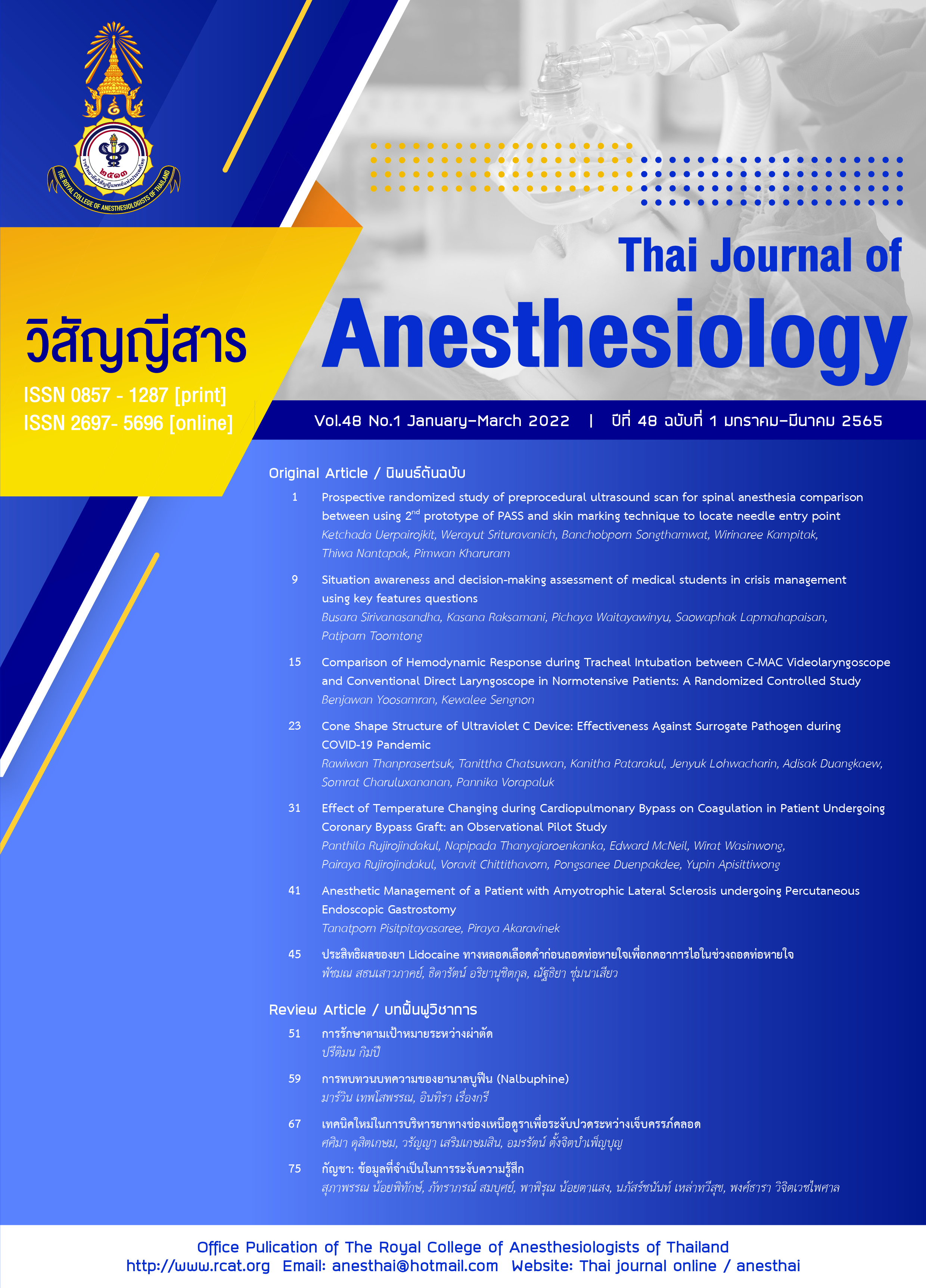Comparison of Hemodynamic Response during Tracheal Intubation between C-MAC Videolaryngoscope and Conventional Direct Laryngoscope in Normotensive Patients: A Randomized Controlled Study
Main Article Content
Abstract
Background: Hemodynamic change during induction of anesthesia and intubation is very crucial particularly in high risk patients. Variety of videolaryngoscopes have been currently launched to provide a good glottic visualization which allows less pressure on the laryngeal area. Aim of this study is to compare the hemodynamic effect of C-MAC videolaryngoscope with conventional direct laryngoscope. Methods: This prospective, double-blinded, parallel group, randomized controlled trial enrolled 114 normotensive patients who underwent elective surgery that required orotracheal intubation. They were randomly allocated into two groups which were 57 patients equally for direct laryngoscope (DL) and C-MAC videolaryngoscope (C-MAC). Mean arterial pressure (MAP) and heart rate (HR) were measured before induction (baseline), after induction (T0), after intubation (T1), and then every minute for five minutes following intubation. Other intubating parameters were recorded. Results: No significant difference in mean difference MAP and HR were detected for both groups. Intubation time was significantly faster in direct laryngoscope group (14.6±4.4 seconds) when compared with C-MAC group (18.9±6.3 seconds) p<0.001. The occurrence of postoperative sore throat was lower in C-MAC group (7%) with a statistically significant difference (p=0.021). Conclusions: There was no benefit of using C-MAC videolaryngoscope for intubation in terms of hemodynamic stability, but C-MAC videolaryngoscope should be considered advantageous over DL for attenuating risk of postoperative sore throat.
Article Details

This work is licensed under a Creative Commons Attribution-NonCommercial-NoDerivatives 4.0 International License.
References
Kamalipour H, Jognataie P, Kamali K. Comparing the combination effect of propofol-ketamine and propofol-alfentanyl on hemodynamic stability during induction of general anesthesia in the elderly. Iran Red Crescent Med J. 2009;11:176-80.
Thomson IR. The hemodynamic response to intubation: a perspective. Can J Anaesth. 1989;36(4):367-9.
Rai MR, Dering A, Verghese C. the GlideScope system: a clinical assessment of performance. Anaesthesia. 2005;60(1):60-4.
Cooper RM, Pacey JA, Bishop MJ, McCluskey SA. Early clinical experience with a new videolaryngoscope (GlideScope) in 728 patients. Can J Anaesth. 2005;52(2):191-8.
Paolini JB, Donati F, Drolet P. Review article: video-laryngoscopy: another tool for difficult intubation or a new paradigm in airway management? Can J Anaesth. 2013;60(2):184-91.
Teoh WHL, Saxena S, Shah MK, Sia ATH. Comparison of three videolaryngoscopes: Pentex airway Scope, C-MACTM, GlidescopeR VS the Macintosh laryngoscope for tracheal intubation. Anaesthesia. 2010;65(11):1126-32.
Alvis BD, Hester D, Watson D, Higgins M, St Jacques P. Randomized controlled trial comparing the McGrath MAC video laryngoscope with the King Vision video laryngoscope in adult patients. Minerva anestesiol. 2016;82(1):30-5.
Asai T. Videolaryngoscopes: do they truly have roles in difficult airways? Anesthesiology. 2012;116(3):515-7.
Xue FS, Li HX, Liu YY, Yang GZ. Current evidence for the use of C-MAC videolaryngoscope in adult airway management: a review of literature. Ther Clin Risk Manag. 2017;13:831-41.
Shribman AJ, Smith G, Achola KJ. Cardiovascular and cathecholamine response to laryngoscopy with and without tracheal intubation. Br J Anaesth. 1987;59(3):295-9.
Kleine-Brueggeney M, Grief R, Schoettker P, Savoldelli GL, Nabecker S, Theiler LG. Evaluation of six videolaryngoscopes in 720 patients with a simulated difficult airway: a multicentre randomized controlled trail. Br J Anaesth. 2016;116(5):670-9.
Xue FS, Zhang GH, Li XY, Sun HT, Li P, Li CW, et al. Comparison of hemodynamic responses to orotracheal intubation with GlideScope videolaryngoscope and the Macintosh direct laryngoscope. J Clin Anesth. 2007;19(4):245-50.
Mogahed MM, Elghamri MR, Anwar AG. Comparative study of intubation performance between Macintosh, the channeled King Vision and the C-MAC D-blade videolaryngoscope in controlled hypertensive patients. J Anesth Clin Res. 2017;8(11):1000780.
Buhari FS, Selvaraj V. Randomized controlled study comparing the hemodynamic response to laryngoscopy and endotracheal intubation with McCoy, Macintosh, and C-MAC laryngoscopes in adult patients. J Anaesthesiol Clin Pharmacol. 2016;32(4):505-9.
Stoelting RK. Circulatory changes during direct laryngoscopy and tracheal intubation: influence of duration of laryngoscopy with or without prior lidocaine. Anesthesiology. 1977;47(4):381-4.
Kanchi M, Nair HC, Banakal S, Murthy K, Murugesan C. Haemodynamic response to endotracheal intubation in coronary artery disease: direct versus video laryngoscopy. Indian J Anaesth. 2011;55(3):260-5.
Ahmed SM, Doley K, Athar M, Raza N, Siddiqi OA, Ali S. Comparison of endotracheal intubation time in neutral position between C-Mac® and Airtraq® laryngoscopes: a prospective randomised study. Indian J Anaesth. 2017;61(4):338-43.
Aggarwal H, Kaur S, Baghla N, Kaur S. Hemodynamic response in orotracheal intubation comparison between Macintosh, McCoy, and C-MAC video laryngoscope. Anesth Essays Res. 2019;13(2):308-12.
Shravanalakshmi D, Bidkar PU, Narmadalakshmi K, Lata S, Mishra SK, Adinarayanan S. Comparison of intubation success and glottic visualization using King Vision and C-MAC videolaryngoscopes in patients with cervical spine injuries with cervical immobilization: a randomized clinical trial. Surg Neurol Int. 2017;8:19.
Ali QE, Amir Sh, Jamil S, Ahmad S. A comparative evaluation of the Airtraq and King Vision video laryngoscope as an intubating aid in adult patients. Acta Anaesthesiol Belg. 2015;66(3):81-5.


